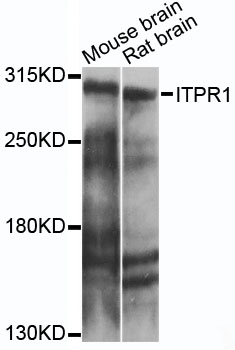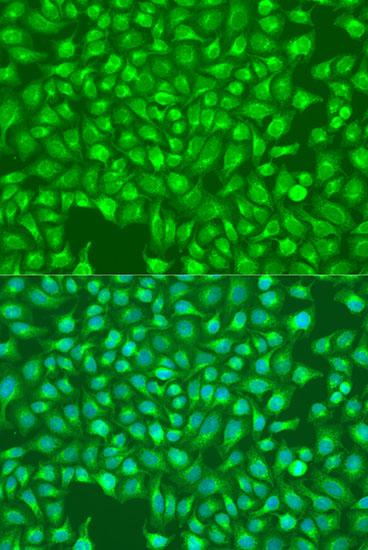-
Product Name
ITPR1 Polyclonal Antibody
- Documents
-
Description
Polyclonal antibody to ITPR1
-
Tested applications
WB, IF
-
Species reactivity
Human, Mouse, Rat
-
Alternative names
ITPR1 antibody; ACV antibody; CLA4 antibody; INSP3R1 antibody; IP3R antibody; IP3R1 antibody; PPP1R94 antibody; SCA15 antibody; SCA16 antibody; SCA29 antibody; inositol 1,4,5-trisphosphate receptor type 1 antibody
-
Isotype
Rabbit IgG
-
Preparation
Antigen: Recombinant fusion protein containing a sequence corresponding to amino acids 1100-1250 of human ITPR1 (NP_001161744.1).
-
Clonality
Polyclonal
-
Formulation
PBS with 0.02% sodium azide, 50% glycerol, pH7.3.
-
Storage instructions
Store at -20℃. Avoid freeze / thaw cycles.
-
Applications
WB 1:500 - 1:2000
IF 1:50 - 1:200 -
Validations

Western blot - ITPR1 Polyclonal Antibody
Western blot analysis of extracts of various cell lines, using ITPR1 antibody at 1:1000 dilution.Secondary antibody: HRP Goat Anti-Rabbit IgG (H+L) at 1:10000 dilution.Lysates/proteins: 25ug per lane.Blocking buffer: 3% nonfat dry milk in TBST.Detection: ECL Enhanced Kit .Exposure time: 10s.

Immunofluorescence - ITPR1 Polyclonal Antibody
Immunofluorescence analysis of U2OS cells using ITPR1 antibody at dilution of 1:100. Blue: DAPI for nuclear staining.
-
Background
Intracellular channel that mediates calcium release from the endoplasmic reticulum following stimulation by inositol 1,4,5-trisphosphate. Involved in the regulation of epithelial secretion of electrolytes and fluid through the interaction with AHCYL1 (By similarity). Plays a role in ER stress-induced apoptosis. Cytoplasmic calcium released from the ER triggers apoptosis by the activation of CaM kinase II, eventually leading to the activation of downstream apoptosis pathways (By similarity).
Related Products / Services
Please note: All products are "FOR RESEARCH USE ONLY AND ARE NOT INTENDED FOR DIAGNOSTIC OR THERAPEUTIC USE"
